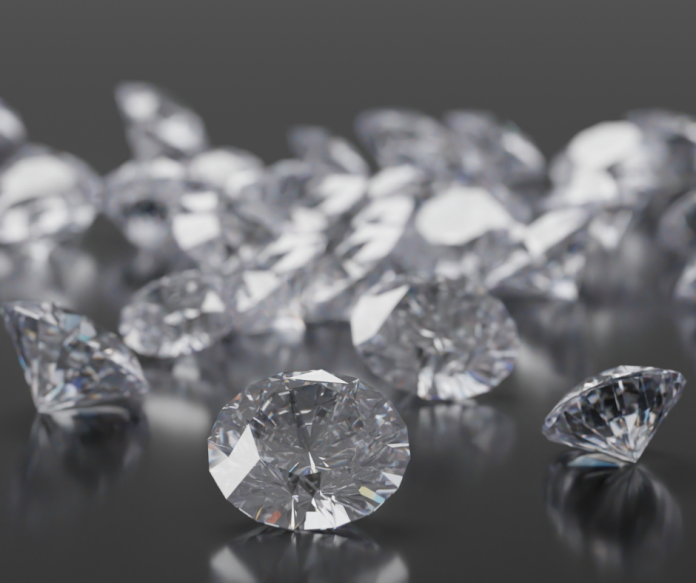
What’s the best diamond alternative? Diamonds may be a girl’s best friend — and the number one choice for engagement rings — but there is a bevy of cleared gems on the market, both naturally occurring and manufactured, that deserve a second look. Alternative stones are chosen for different reasons such as budget constraints, sentimentality (such as a birthstone or a piece being an heirloom), or personal preference. Some may also prefer to keep their diamond jewelry at home when traveling or when concerned about potential damage or loss.
Helping With Diamond Alternative Choices
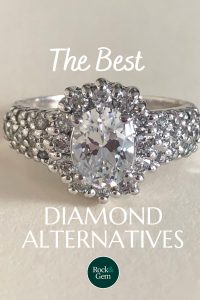
GIA-certified gemologists Lindsey Carr and Julie Walton Garland have not only studied the properties of gemstones, it’s their business to help customers make informed decisions when it comes to purchasing jewelry.
Carr, based in Redditch, UK, serves as an on-air host for the British television and online jewelry retailer, Gemporia. She is also an Applied Jewelry Professional (AJP). Carr notes that fewer diamonds are on the market because of sourcing difficulties and this is driving up prices. She also advises that people know some of the science behind the stone when they are purchasing a diamond alternative.
“You want to pay attention to a stone’s hardness, measured on a scale from one to 10. Gemstones that score below a seven require a little extra care and caution,” said Car.
Garland is the third-generation owner of Walton’s Antique and Estate Jewelry in Franklin, Tennessee. She points out that diamonds made in a lab and moissanite have become popular selections as a diamond alternative in recent years because you can own a larger carat weight for less, avoid potentially buying a conflict diamond and steer clear of the environmental issues associated with mining.
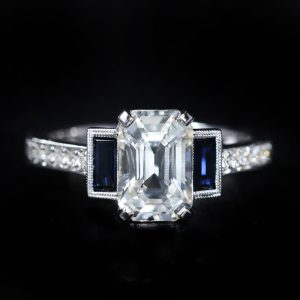
Courtesy of Julie Walton Garland.
White Sapphire
While sapphires, like Montana sapphires, are best recognized in blue and pink shades, the white or clear variety also has a lot to offer the consumer. Sapphires are one of the four most sought-after precious gems (the others being diamonds, rubies, and emeralds). The stone is a variety of corundum, which is aluminum oxide, and is a nine on the Mohs Hardness Scale.
You can usually tell a white sapphire from a diamond because these stones process light by returning a silvery white-gray sparkle in the light, whereas diamonds have a rainbow-hued glint. Carr noted they can also have a cloudy, milky appearance compared to diamonds, particularly in big sizes.
Garland says wearing white sapphires daily as a diamond alternative can lead to them looking dull across the top and becoming susceptible to chips or scratches.
“The price gap between a diamond and a white sapphire is significant,” Carr said. “Some sources say that while a white sapphire of high quality (6mm in size) fetches around $730, a colorless diamond of the same size can cost $2,900 or more.”
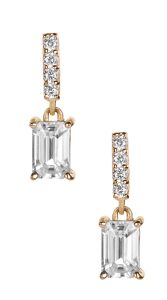
Courtesy of Gemporia
White Zircon
Zircon (not to be confused with zirconium and cubic zirconium) is the oldest gemstone on earth: 4.4 billion years old. It is a mineral belonging to the group of nesosilicates and is a source of the metal zirconium. The colorless variety is known as “Matara” after a city in Sri Lanka near where it is found. Some of its most desirable shades include blue, red, yellow, green, pink, grey, purple, brown and orange.
“Because of their similarity to diamonds, it’s the only natural gem to come close to imitating a diamond,” Carr said. “High sparkle, luster, dispersion and refraction — everything I love about a diamond. It plays excellently with light, making it a brilliant, fiery gemstone.”
Garland echoed that sentiment, adding that zircon is known for its doubling effect, or double refraction, which is when a ray of light passes through the gemstone, is slowed, bent and split in two.
Sometimes, zircon is confused with the manmade stone cubic zirconia. Zircon can be brittle (its hardness is only 6-7.5). It should be worn with care to avoid scratches or chipping.
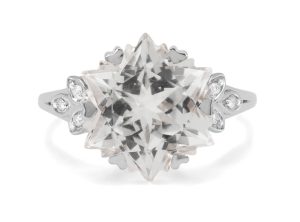
Courtesy of Gemporia
White Topaz
Topaz is a silicate mineral. The white, or clear hue, offers exceptional gleam and is one of the most affordable diamond alternatives – acarat of topaz costs less than $200. “I would choose a topaz over a laboratory-created gem any day of the week,” said Carr. While topaz is an eight on the Mohs scale, she points out that’s relative unless you understand how the ranking works.
“Diamond is a 10. In actuality, diamonds are really over six times harder than topaz,” she explains. “The stronger the refraction, the more brilliant the gemstone. Diamond has a refractive number of 2.42. Topaz is 1.64 — only a fraction in comparison to diamonds.”
Garland said topaz gradually loses its sparkle over time from scratches. White topaz is commonly used as an accent stone to encircle a usually pricier gem and will look like diamonds, minus the price tag.
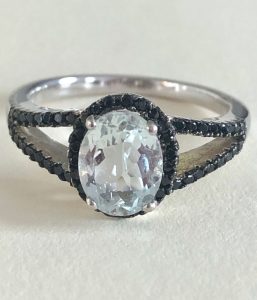
Courtesy Sara Jordan-Heintz
Goshenite
Goshenite is a type of beryl, a gem known as “the mother of all gemstones” because beryl can be transformed into stones including emerald, morganite and aquamarine. It is composed of beryllium aluminum silicate.
“Beryl is notoriously going to have some inclusions; emerald is practically always included,” said Garland. “Black inclusions are more noticeable to the naked eye, but there can be colorless inclusions as well.”
It gets its name from Goshen, Massachusetts, one of the first areas where the stone was uncovered, but it can also be found in Brazil and Canada. Its hardness ranges from 7.5-8.
Garland said if you don’t plan to wear it at all times, it can make an excellent choice for special occasions. Carr agrees.
“It’s a rare stone,” Carr said. “My manager at work has a goshenite as an engagement ring and it looks incredible. And of course, you can get the bigger stones for a more affordable price.”
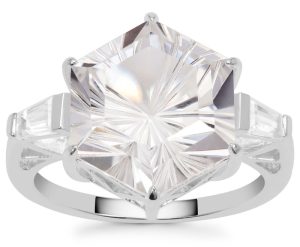
Courtesy of Gemporia
Quartz
Quartz is the least expensive diamond lookalike. It is made of silicon and oxygen. The quartz crystal is known as a power stone. The clear variety is considered a “master healer” that can increase energy and focus. Its colored varieties include: citrine, amethyst, rose quartz and smoky quartz.
Herkimer diamonds are designated the official state mineral of New York. They are naturally faceted (18 facets) quartz found in upstate New York. Herkimer diamonds share many physical properties attributed to quartz. They are almost always transparent and range from colorless (“water clear”) to smoky/ black. Many couples now travel to New York to dig their own “Herks” to use in engagement/wedding rings and in other jewelry pieces.
“It (quartz) is a great alternative to diamonds when faceted and they emit the most amount of light, making them appear more sparkly than they actually are,” Carr said.
She loves seeing topaz and quartz stones cut in non-traditional designs such as a snowflake or alpine. “Anything that has a little bit of difference, with loads of facets, those gemstones bring it to life,” she added.
It’s important to note large quartz stones have a glassy appearance.
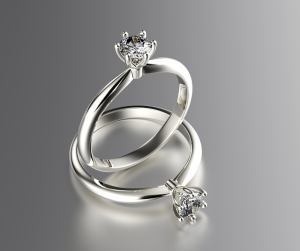
Moissanite
Moissanite is the most popular diamond alternative on the market for engagement rings, and with good reason. On the Mohs scale, it’s a 9.25 to 9.50, is resistant to scratches and abrasion and greatly resembles diamonds, particularly to the untrained eye.
Moissanite is a rare mineral discovered by French chemist Henri Moissan in 1893 in a crater made by a meteorite that fell to Earth in Arizona. Its crystals are composed of silicon carbide. However, because natural moissanite is scarce, moissanite sold today as a diamond alternative is lab-created.
“Diamonds are always going to hold true to being the most suitable stone for everyday wear, but the next best choice in terms of durability and wear, would be moissanite,” Garland said. “It’s the best simulated, so it’s going to look the most like a diamond. It will be much less expensive too.”
Garland said it also refracts the light a little bit more than diamonds. While this intense sparkle is alluring to some, others feel it has a “disco ball” look, particularly in sunlight.
“Like white sapphire, moissanite is most often colorless, although it can be tinged with hints of yellow or green,” Carr added.
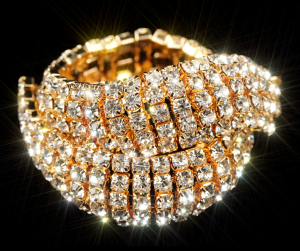
Cubic Zirconia
Cubic zirconia is the most readily available diamond simulate. Mass-produced, it’s often used in costume jewelry. It has a hardness of eight.
Cubic zirconia is a form of zirconium dioxide. Carr noted cubic zirconia can occur naturally, but never in amounts that can be used commercially. It is usually colorless and contains few if any inclusions. Jewelry using this stone will often be stamped “CZ.”
“If you’ve ever seen sterling jewelry with CZs set in it, worn all the time, it’s going to look kind of like it went through the disposal, in terms of getting a chipped, abraded surface,” Garland explained.
Carr said this diamond alternative requires repeated polishing to maintain its luster but can be a great diamond substitute for cocktail rings, bracelets, necklaces and earrings.
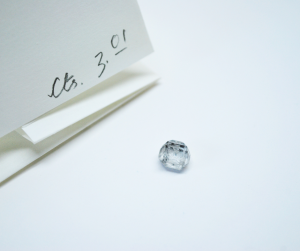
Lab-Grown Diamonds
Lab-grown diamonds, sometimes called cultivated diamonds, are genuine stones formed above ground in a matter of weeks instead of below ground for millions or billions of years, using one of the following techniques.
• High Pressure, High Temperature
(HPHT): These diamonds are created in a lab using a growth chamber. A source of carbon dissolves in molten metal and carbon atoms travel through the metal to a small created or natural diamond seed to produce a diamond crystal.
• Chemical Vapor Deposition (CVD):
This technique uses carbon-rich gas, such as methane, in a vacuum chamber. Methane gas breaks down into carbon and hydrogen atoms, which are deposited on diamond seeds to produce a square-shaped, tabular diamond.
Lab-grown diamonds are a 10 for hardness — just like natural diamonds. According to the Gemological Institute of America, the way diamonds grow (natural and manufactured) depends on the environment where they are grown.
• Natural diamonds grow outward on the octahedral faces.
• HPHT diamonds grow outward on the octahedral and cube faces.
• CVD synthetic diamonds grow mainly upward in one direction (a cube face).
Garland said the harder the gem, the better its durability and heirloom potential. These also tend to have a higher asking price.
“To me, something created in a lab is never going to stand up next to diamonds, in terms of quality,” she noted. “Lab diamonds became really popular a couple of years ago, but prices have plummeted as of late. Diamond will hold its value better than anything else.”
Whether you select white sapphire for its durability, moissanite for its sparkle, zircon or topaz for its brilliance, quartz for its low price, or lab-made stones for sustainability or cost reasons, these diamond alternative gems are sure to bring joy for years to come with the proper care.
This story about best diamond alternatives previously appeared in Rock & Gem magazine. Click here to subscribe. Story by Sara Jordan-Heintz.















